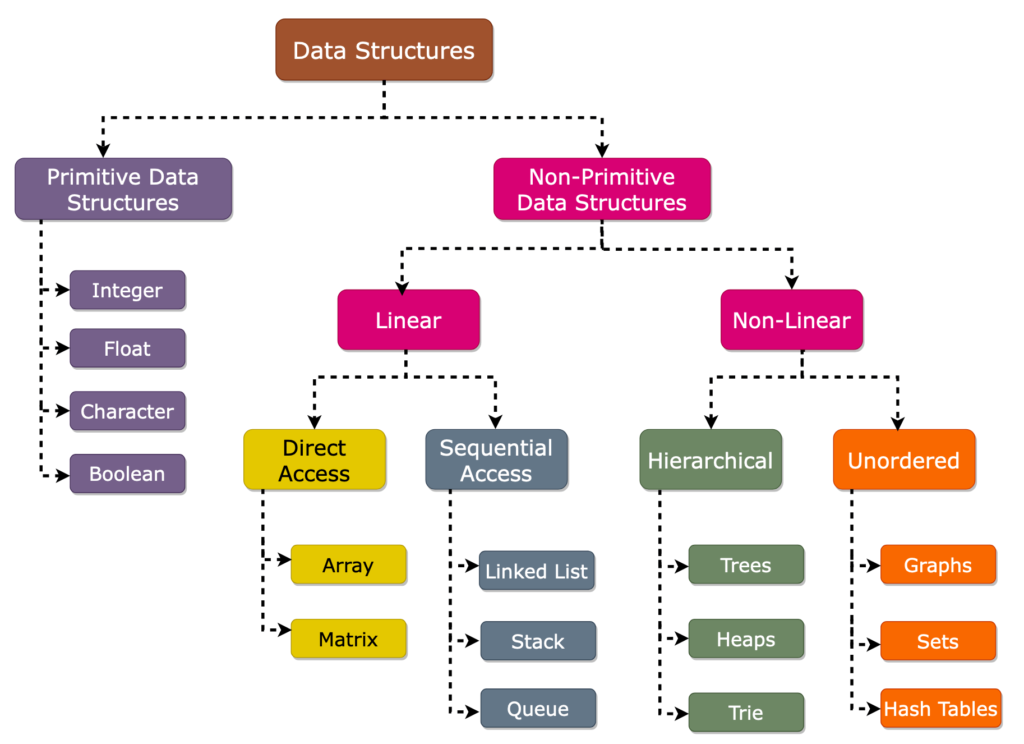What is Data Structure
In this tutorial, we are going to discuss about What is Data Structure. Data structures are the building blocks of programming. Without them, we couldn’t structure, store, or handle data efficiently.
Whenever we want to work with large amount of data, then organizing that large amount data is very important. If that data is not organized effectively, it is very difficult to perform any task on that data. If that data is organized effectively then any operation can be performed easily on that data. A data structure can be defined as follows:
“Data structure is a method of organizing large amount of data more efficiently so that any operation on that data becomes easy”.
Let’s visualize this concept further. Consider a library filled with books. Without any particular structure or arrangement, finding a book in this library would be a challenging task. But, if we arrange these books by genre, author, or title, it becomes much easier to locate a specific book. This is the essence of data structures – they help us manage, organize, and use data more effectively.
Based on the organizing method of a data structure, data structures are divided into two types.

- Primitive Data Structures
- Non-Primitive Data Structures
1. Primitive Data Structures
- Primitive data structures are the data structures available in most of the programming languages.
- These data structures are used to represent single value.
- Primitive Data Structures are the basic data structures that directly operate upon the machine instructions.
- Imagine you’re making a shopping list. What do you need? Probably fruits, vegetables, snacks, maybe some cleaning supplies. Each of these items can be considered an individual data element – a building block of your list. Primitive data structures in programming are similar. They are the simplest form of data structures and include:
- Integers: Think of these as whole numbers, like the number of apples you need to buy.
- Float: These are real numbers, like the weight of the bananas you’re planning to buy.
- Character: A single letter, number, or symbol, like ‘A’ or ‘3’.
- Boolean: This type holds either a true or false value.
Data Types
In java every variable and every expression should has some type. Each and every type is clearly defined. Every assignment should be checked by compiler for type compatibility. Because of above reason we can conclude Java language is Strongly typed programming language.
Java is not considered as pure object-oriented programming language. Because several OOP principles are not satisfied by Java (like operator overloading, Multiple inheritance etc.). Moreover, we depending on primitive data types which are not objects.
Based on the data type of a variable, the operating system allocates memory and decides what can be stored in the reserved memory. There are two data types available in Java:
- Primitive Data Types
- Reference/Object Data Types
2. Non-Primitive Data Structures
- Non-primitive data structures are more complicated data structures and are derived from primitive data structures.
- Non-Primitive data types are used to store group of values.
- Array, Stack, Queue, Lists, Graphs etc. Comes under this category.
- Non-Primitive Data Structures again divided into 2 types
- Linear Data Structures
- Non – Linear Data Structures
1. Linear Data Structures
If a data structure is organizing the data in sequential or linear order, then that data structure is called as Linear Data Structure. Data elements in a liner data structure are traversed one after the other and only one element can be directly reached while traversing. Examples of linear data structures are Array, Stack, Linked List and Queue.
Operations on linear Data Structures
- Traversal: Visit every part of the data structure
- Search: Traversal through the data structure for a given element
- Insertion: Adding new elements to the data structure
- Deletion: Removing an element from the data structure.
- Sorting: Rearranging the elements in some type of order (e.g Increasing or Decreasing)
- Merging: Combining two similar data structures into one.
2. Non – Linear Data Structures
The data structure where data items are not organized sequentially is called Non-Linear data structure. In other words, if a data structure is organizing the data in random order, then that data structure is called as Non-Linear Data Structure. Examples of Non-Linear data structures are Tree, Graph, Dictionaries, Heaps etc.
Understanding the World Through Data Structures
Every process or system in the world is made up of structures. Be it the solar system, a skyscraper, or even our own bodies, each consists of elements arranged in a particular manner, serving a specific purpose. Data structures in programming mirror this universal principle. They provide the framework that holds data together.
Why Study Data Structures?
Understanding data structures will boost your problem-solving skills and enhance your programming thinking ability. Let’s break this down:
- Efficiency: Efficient software or applications are every programmer’s goal. By using the appropriate data structure, you can drastically improve the efficiency of your code.
- Problem-solving Skills: Once you master data structures, you’ll find it much easier to solve complex problems. It’ll be like having a well-organized toolbox, where you know exactly what tool to use and when.
- Career Advancement: Regardless of the programming language you work with, data structures are fundamental to computer science. A strong understanding of data structures can significantly improve your career prospects.
That’s all about the What is Data Structure. If you have any queries or feedback, please write us email at contact@waytoeasylearn.com. Enjoy learning, Enjoy Data Structures.!!